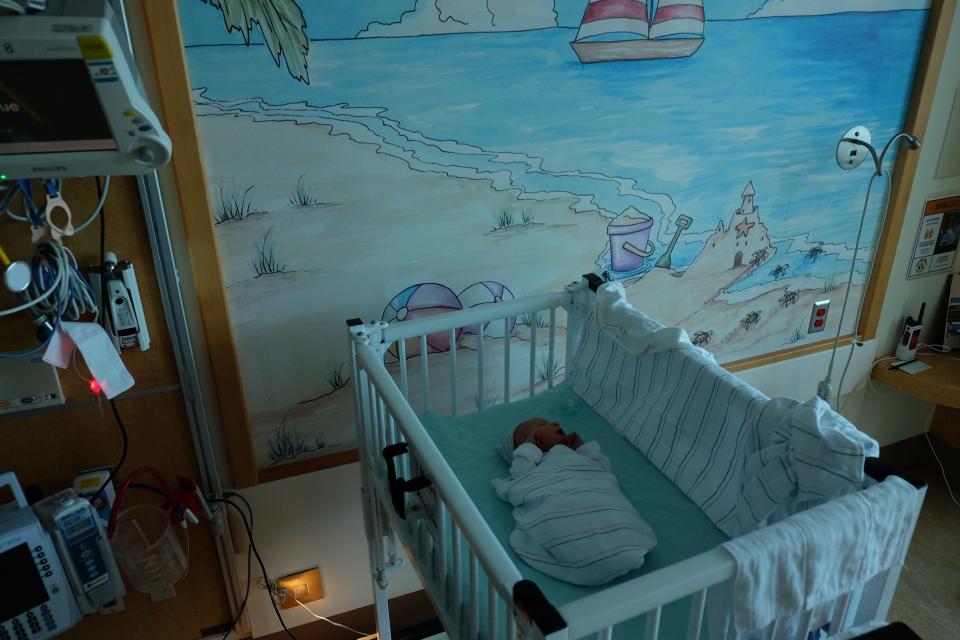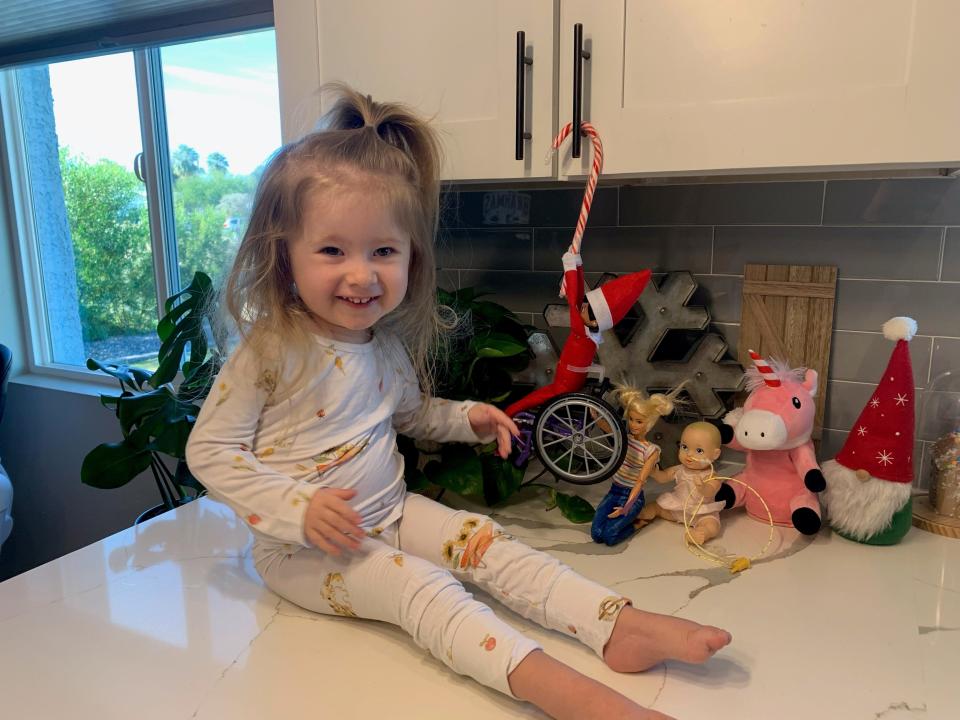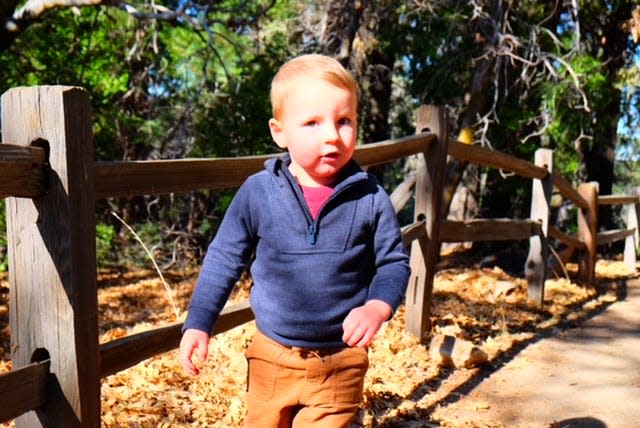Baby Fitz was born without an immune system. His treatment offers hope for curing rare diseases.

Fitz Kettler was born June 21, 2019, without a functioning immune system.
Babies with his condition, commonly known as "bubble boy disease," rarely survive to toddlerhood. Routine colds and germs prove lethal.
But Fitz was seemingly cured before his first sniffle.
He became one of the first babies anywhere to get a specific diagnosis within days of birth and an experimental therapy several months later that appears to have worked. He's now a "permanently happy," extremely cute and very typical 2-year-old, who loves to run barefoot, mop the floor and assert his independence. "Fitz do it!" is his favorite phrase.
His story offers a glimpse into the future for rare inherited diseases.
Like Fitz, a newborn could be diagnosed shortly after birth, or even before, with effective treatment begun in time to prevent irreversible damage – the only evidence of illness a note in a medical chart.

The medical advance doesn't mean an end to all rare diseases. Not every one of the 7,000 known childhood conditions is caused by a simple glitch in a gene. And even if a genetic fluke can be reversed shortly after birth, the child might already have lost brain or muscle cells, requiring extensive, ongoing therapy to participate in daily activities.
In the coming years, scientists hope to end a number of illnesses that have caused misery for generations – sickle cell disease, cystic fibrosis, hemophilia, PKU and a host of lesser known conditions – at least in places and among people who can afford state-of-the-art care.
CHOOSING HOPE
The fifth in an occasional series exploring how scientific advances are transforming care for rare diseases.
"It's a wonderful time in gene therapy," said Harvard geneticist George Church, a pioneer in genetic sequencing and editing.
For decades now, most newborns have been pricked on the heel on their first or second day of life, and their blood spot screened for as many as 50 different diseases, depending on where they live.
For some conditions, like PKU, short for phenylketonuria, such early identification means the child can avoid eating protein, which would otherwise devastate their developing brain. For others, like sickle cell, early knowledge means starting medications and helping parents prepare for the pain crises to come.
As important as these early indications are, they haven't, until recently, led to completely different trajectories or cures.
That's the promise of gene therapy.
Sequencing in record time
First a newborn with a life-limiting disease has to be identified.
California has screened newborns for severe combined immunodeficiency, better known by its acronym SCID, since 2010.
Rady Children's Hospital in San Diego has been working to speed up its genetic screening to reassure parents or give them the worst news of their lives.
"The genome is a gateway to knowing the precise cause of a child's illness and thereby getting them the appropriate therapy," said Dr. Stephen Kingsmore, president and CEO of Rady Children's Institute for Genomic Medicine.

Kingsmore's team earned itself a spot in Guinness World Records in 2018 when it sequenced a baby's genome in a record-breaking 19.5 hours.
A year ago they did even better, diagnosing a child with thiamine metabolism dysfunction syndrome 2, a potentially fatal seizure disorder, 17 hours after obtaining a blood sample and 13 hours after initiating sequencing.
The 5-week-old had come to the hospital crying inconsolably. A decade earlier, his parents had lost their 11-month-old daughter, whose never-diagnosed disease had started the same way.
The boy's seizures could have been triggered by any of about 1,500 conditions. The quick diagnosis allowed the hospital to determine the cause and start treatment.
Six hours later, his seizures had stopped and he was "alert, calm, and bottle feeding," according to a case study published in June. "After a further 24 hours passed without seizures, the patient was discharged. He is now thriving at 7 months of age."
"That's our goal: We try to turn around our results in a day or two or three days," Kingsmore said. "For the sickest kids, we want them to get a diagnosis immediately, before the doctors start trying alternate therapies."
He is now building up a genetic database of at least 10,000 babies with rare diseases, sequencing samples from the sickest children in 70 hospitals across the U.S. and Canada. The project Tipping Point 10,000 project aims to train providers to use genetic information and build evidence to persuade payors that rapid whole genome sequencing should be standard-of-care for newborns hospitalized with diseases of unknown cause.
Getting kids out of intensive care units and home faster saves money as well as families' emotional distress. Rady has been charging $8,500 per child for the sequencing but is trying to get the price below $5,000, Kingsmore said. In the next year or two, he hopes to develop a $200 test that could be used by hospitals around the world to rapidly diagnose 600 known rare diseases in newborns.
In the meantime, FedEx packages arrive every morning at Rady with genomic samples from babies. The staff quickly classifies them into those that need rapid testing, because the child is hospitalized but stable, and those that need ultra-rapid speed, because "we need an answer today," Kingsmore said.
"There are those odd cases where even a day can cost a child's life or their brain function."
The gene therapy decision
When Christina Kettler picked up the phone the day after leaving the hospital with her first child, she was impressed by the personal attention from her doctor. But it wasn't a postpartum check-in. His heel stick showed a problem.
The doctor insisted the Kettlers pack a bag and rush to Rady Children's to be placed into an isolation room.
Before Fitz was 8 days old, doctors confirmed not only that he had SCID but exactly which of about 20 different forms of the disease. His, Artemis SCID, was among the rarest, with the worst outcomes.

It was all very confusing to the new parents, who had never heard of SCID or genetic sequencing. They were so overwhelmed they could barely follow what doctors said. The diagnosis was fatal.
"It was just really difficult to wrap my head around that," Kettler said. "I'm looking at my baby who looks as perfect as can be."
They were given the option of a bone marrow transplant to give him healthy immune cells, and a match was quickly found. But Fitz's form of SCID meant a transplant was likely to help for only a limited time.
The Kettlers decided instead to join a gene therapy trial that might or might not save him.
"I wanted his life to be worth something and to matter, and if he could help other kids down the road with this same condition – that was how I decided on the gene therapy trial," Kettler said.
In May 2019, the Food and Drug Administration approved the first gene therapy to treat a rare inherited disorder, spinal muscular atrophy or SMA.
Children with the worst form of SMA slowly lose control of their muscles and never learn to roll over or crawl. They are unable to swallow, eventually require ventilation to breathe and usually die before their second birthday.
The first 10 babies to receive high doses of the gene therapy, Zolgensma, now marketed by Novartis, have survived toddlerhood and preschool and are now kindergartners and first graders. None needs mechanical ventilation. The ones who got the drug the earliest had the best outcomes.
But the drug isn't a cure-all. Children still need aggressive physical therapy, and some are still tethered to oxygen. Not all can walk on their own.

Stella Lackey was about 1 month old when doctors in Phoenix confirmed her parents' worst fears. She had SMA1 and was already losing muscle control. Zolgensma had been approved six days earlier, and she was given the therapy at 5 weeks. She will continue to get physical and occupational therapy as long as possible, her mother Samantha Lackey said.
Stella uses a wheelchair but sits on her own, eats solid food, doesn't need supplemental oxygen and recently rolled fully over for the first time.
Lackey was so devastated by the diagnosis that at first she couldn't even cry. Tears came for the first time when Stella's nurses were overcome with emotion as they watched her become the first baby in Arizona to receive Zolgensma.
"Three weeks (earlier), we thought we were going to lose our baby, that there wasn't any hope," Lackey said, choking up at the memory. "Now, I have a 2-year-old, who is turning 3 in May, who is the most independent, ferocious, sassy toddler that I could have ever imagined."
She has since argued successfully to get the disease added to Arizona's newborn heel stick tests. If Stella's disease had been caught a few days instead of weeks after birth, she might have had a different trajectory.
Still, the number of inherited diseases that can be treated with gene therapies remains quite limited. Biotech executives talk about developing gene therapy "platforms," but knowing how to treat a disease requires a deep understanding that isn't often transferrable to the next.
"Right now, on rare diseases, you have to approach them as one-offs, and there's just not enough money in the world to be able to get very far with those disorders that are, many of them, extremely rare," said Dr. Francis Collins, longtime director of the National Institutes of Health, who is stepping down at the end of this year.
The NIH's Common Fund has been supporting efforts to better understand and address challenges with gene therapy.
"Part of it is about delivery," Collins said. "And part of it is about designing the gene editors to be ever more clever, so that you can go and change a single letter of the code without leaving any footprints."
Finding, fixing problems before birth
For 30 years, surgeons have operated during pregnancy to close gaps in the backbones of fetuses with spina bifida. Fetal heart surgeons regularly stitch up holes that don't belong.
Someday, it may be possible to address other genetic defects before birth.
Several researchers are studying the possibility of conducting gene therapy on fetuses. One of the goals, according to a paper published in February 2020, is "ultimately, the ability to treat diseases in which irreversible pathology begins prior to birth."
Russell Kirby, an epidemiologist specializing in maternal and child health, said he's optimistic about the idea of fetal gene therapy over the long term but skeptical at the moment. He and several colleagues wrote a critique of the approach earlier this year.
Even after fetal surgery, children born with spina bifida have lingering health problems, Kirby said, probably because scientists don't fully understand the condition and all its ramifications. Most research tracks whether a fetus who had heart surgery lived or died, not the long-term outcomes of children with congenital heart defects.
"We need to let our scientific and clinical trials processes play out and make sure we really understand both," said Kirby, a professor at the University of South Florida School of Public Health.
Many birth defects, probably more than half, remain poorly understood. Some genetic diseases are evident in only some of the cells, which would make it harder to diagnose and correct before birth, or even to know if they need correcting, he said.
But it's now feasible to identify genetic disorders early in pregnancy, simply by analyzing the mother's blood.
Stephen Quake, a professor of bioengineering and applied physics at Stanford University, developed the technology that finds fetal DNA in the bloodstream of the mother – a proverbial needle in a haystack.
"It's possible to diagnose pretty much any genetic condition before birth," Quake said. "The question is, what are you going to do about it?"
In children born with an inability to process certain foods, "diagnostics are going to be pretty powerful," he said. In other conditions like Down syndrome, in which the child has an extra chromosome in every cell, there's no easy fix and people with the condition can lead fulfilling lives.
In recent years, Quake and his colleagues have developed a method for analyzing the RNA from the fetus. If DNA is a cell's rulebook, RNA is what turns that book into actions. But RNA is much smaller – a sentence on one page – so it was harder to separate from the mother's bloodstream.
Quake's been using this fetal RNA to help diagnose dangerous conditions like preterm delivery, which affects 10% of all births, and preeclampsia, which can be fatal for both mother and child. The same technology used to identify unusual conditions is now offering insights into frequent ones, Quake said, "transforming the field of diagnostics from looking for genetic disorders, which are very rare, to things that are very common."
Although he helped invent the tools that enable gene therapy, Harvard's Church says the most effective way to solve genetic diseases is to prevent them from happening at all.
Church has financially backed two dating apps, hoping genetics can help steer people away from a match that could lead to children with an inherited lethal disease.
This isn't eugenics, Church insisted. He's not trying to limit genetic diversity, just eliminate a few people out of billions from a woman or man's choice of a mate.
He compared the idea to the accomplishments of Dor Yeshorim, an organization that helped dramatically reduce the deadly disorder Tay Sachs from the Jewish population by discouraging matches between carriers.
This approach could also save huge amounts of money, Church said. It costs nothing for people not to meet. Every child born with a severe rare disease in the U.S. requires more than $1 million in medical care.
Genetic counseling also carries far few risks than gene therapy.
"That's the reason I'm excited about it," Church said. "You can really solve 1,000 different genetic diseases with the same tool."
Waiting pays off, for now
Christina Kettler, a marketing contractor, was over 40 when she and her husband, Daniel, a construction engineer, decided they wanted children.
With donor eggs and his sperm, the embryos were checked for common genetic defects before implanting. Such embryonic reviews typically look only for common diseases, they now know.
After rushing Fitz to Rady’s isolation room in late June 2019, the newborn and his parents stayed there for six days, and then isolated at home for another month.
On Aug. 4, the family drove to the University of California, San Francisco, where they would live, again in isolation, for four months, as Fitz became the seventh child to participate in a gene therapy clinical trial for Artemis SCID.
Doctors harvested his bone marrow. In a lab, scientists corrected the genetic mistakes in his stem cells.
Fitz was cranky but nothing worse during his two days of chemo on Aug. 27 and 28. The toxic chemicals were meant to make room for the treated cells to become established and build an immune system.
The next day, a milky white liquid containing the corrected cells was infused into his tiny body. It took all of 20 minutes. "The transplant itself feels a little anticlimactic," Christina Kettler said.

Then the waiting began. "Three months of waiting. And waiting. And waiting."
Kettler chronicled their hopes and boredom for family members and friends.
In early December, Fitz was cleared to go back home to San Diego to isolate again. A few months later, COVID-19 struck, and everyone else understood what the Kettlers endured for months.
"I think the world knows better now that fear of going to the grocery store, but that's how we were living 8 months before the pandemic hit," Kettler said. "Not trusting people, not knowing if they were safe or not to be around. It's just exhausting."
Fitz did well every step of the way in the trial. "He had no issues with chemo, surgery – he never had any issues with anything," said his mom.

Now Kettler is back to imagining a future for their toddler.
"He's such a character. I can't wait to watch him grow up," she said. "He has the best sense of humor."
He also has had his first cold and his first live vaccine – both cause for celebration.
"His immune system handled it beautifully. I'm so proud of him and his man-made immune system," Kettler said. "We are over the moon!"
She's also 17 weeks pregnant, with an embryo carefully screened for SCID. It's a good idea for Fitz to have a sibling, Kettler said. In case he ever needs a bone marrow transplant, his little sister might be able to help.
No one knows whether the gene therapy will last forever. Fitz will stay in the trial until he's about 17. But for now, Kettler is thrilled and thankful.
"I'm so grateful that these scientists, these researchers are making these things happen. The future is here. It's now, and it's saving lives."
Contact Karen Weintraub at kweintraub@usatoday.com.
Health and patient safety coverage at USA TODAY is made possible in part by a grant from the Masimo Foundation for Ethics, Innovation and Competition in Healthcare. The Masimo Foundation does not provide editorial input.
More in this series
Decades-long quest to beat Fragile X fueled by persistence, science and relentless optimism
What’s in a name? For families desperate for a diagnosis, knowing the cause of illness matters
Two women, worlds apart, and a rare disease that could offer clues about ALS
This article originally appeared on USA TODAY: The future of gene therapy could cure rare diseases in the womb

